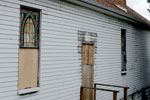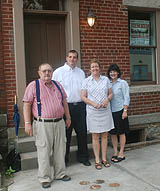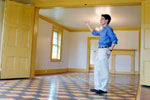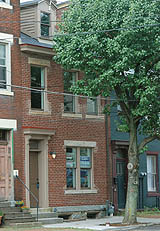
Category Archive: News Wire Services
-
Historical Groups Left in Lurch by Funding Cuts
By Richard Robbins, Pittsburgh TRIBUNE-REVIEW
Sunday, July 25, 2010
Museum inn keeper and Curator Jim Koontz, of Ligonier, builds a birdhouse that is being modeled after the Laughlintown museum's cook house. Barry Reeger/Tribune-Review
Just two years ago, Soldiers & Sailors Memorial Hall & Museum, the Oakland landmark honoring veterans of all of America’s wars, was on the receiving end of a nice piece of change from Pennsylvania: $260,000.
In 2009, the state’s largesse shrank dramatically, to a mere $30,000.
This year, Soldiers & Sailors is in line to get nothing, a result of a state budget that eliminated grants for historical sites, from the 218-acre Bushy Run Battlefield in Penn Township to the smallest local historical society.
The funding cuts will have a huge impact on groups devoted to local history, according to Ronald Gancas, Soldiers & Sailors president and CEO.
He foresees severe retrenchments, including the continuation of a wage freeze in effect at Soldiers & Sailors since 2007 and the need to recruit and mobilize even more volunteers. The museum’s education department has gone from five full-time and two part-time employees a few years ago to one full-time and one part-time employee today.
“If this trend continues, it will take 50 years to put things back together,” Gancas said.
The 2009 state budget contained $1.7 million for regional and local history, a sum that the state House added after several months in which it appeared there would be no funding for historical groups.
But this time around, there was no late change to rescue local history grants, either for general operations or special projects.
There was lip-service support for public history from members of the General Assembly but nothing more, said Deborah Filipi, executive director of the Pennsylvania Federation of Museums and Historical Organizations.
“We are in a crisis, there is no doubt about it,” Filipi said. “There are some museums that are already hurting. I suspect some of these are not going to survive.”
Jeremy Burnworth, president of the Fayette County Historical Society, said the funding cuts could not come at a worse time for his group, which conducted a ribbon-cutting ceremony Friday at its new museum and headquarters in a renovated 1700s building.
“This is really bad timing,” Burnworth said, adding that the historical society will be “held back without” the state dollars. He was counting on $10,000 from the state and a $10,000 match from the county to help staff the museum and the Searight Tollhouse, both along the National Road.
“We were on track” for the funding, Burnworth said. Now the game plan is to utilize volunteers in place of paid staff.
Tina Yandrick, director of operations for the Ligonier Valley Historical Society, said the expiration of funding meant elimination of summer internships cutting general maintenance “over and above the usual.”
Yandrick noted Compass Inn, a restored Laughlintown stagecoach stop built in 1799, “always” needs refurbishing.
Nevertheless, she said, “we are fortunate we have Compass Inn,” a money-maker for the society that helps to offset the loss of state money.
State funding was “always important money for us,” said Lisa C. Hays, executive director of the Westmoreland County Historical Society, adding that money has been so scarce, “I’m trying to get through this month.”
“We’ve already tightened our belts a lot,” Hays said. She forecast the potential for shorter business hours beginning in 2011 to “save staff time.” However, because the society likely will make a greater effort to raise private dollars, Hays was uncertain if savings are actually possible.
-
Vandergrift Moves to Preserve Look of Borough Property
By Rossilynne Skena
VALLEY NEWS DISPATCH
Monday, July 26, 2010Borough residents who cut down trees between the sidewalk and the curb could face a fine.
Those trees are borough property, officials say.
A new ordinance would enforce that by prohibiting residents from trimming or removing trees along the street — even those in front of their house.
Councilwoman Kathy Chvala leads the borough’s tree committee, which includes two other council members and four residents.
Chvala said the fine for a resident cutting down a tree along the street has not been determined.
She said the property owner would be billed for the cost of replacing the tree.
She expects council to consider the matter in September.
Chvala said she’s heard mostly positive feedback.
The only negative feedback she’s heard is from people who want to have a tree cut down when it’s healthy.
“We really want to maintain what we have,” she said.
But council president Brian Carricato said “trees are a very touchy issue in town.”
It’s not just residents who want to cut down healthy trees that they don’t want. He said but others insist on keeping dying trees standing.
Mayor Lou Purificato said property owners cutting trees down on their own doesn’t happen often.
Carricato said the committee wants to keep the town looking the way it does.
“The last thing you want to do is drive down a street with trees and now they’re all cut down,” he said.
Chvala remembers beautiful fall foliage along Vandergrift’s curved streets.
“There was a time that there was twice as many trees in town,” she said. “Probably more than that.”
Chvala likes to see healthy trees bloom again in the town with colorful autumn leaves.
Removing dead trees
While trying to save healthy trees, the borough has awarded a contract with a tree service to clear out the dead ones.
By fall, the tree committee will start placing those trees with healthy ones.
M&M Tree Service of Apollo has been awarded a contract worth between $4,500 to $5,000 for tree removal or trimming, Chvala said.
Nine types of dead trees will be removed along Hancock Avenue, West Adams Avenue, East Adams Avenue, Sherman Avenue, and Lafayette Street.
Eleven trees along Hancock Avenue, Sherman Avenue, Jefferson Avenue, Harrison Avenue, Franklin Avenue and Lafayette Street will be trimmed.
The tree committee is looking for donations, Chvala said. Anyone who is interested in donating should contact the borough secretary at 724-567-7818.
Contributing writer Dale Mann contributed to this report.
-
Foundation Offering Money to Help Churches Pay For Repairs
By Jodi Weigand
PITTSBURGH TRIBUNE-REVIEW
Monday, July 26, 2010
Stained-glass windows at First Baptist Church of Glassport were vandalized Thursday. The church hopes to obtain help from the Pittsburgh History & Landmarks Foundation's Historic Religious Properties Program to make repairs. Jasmine Goldband | Pittsburgh Tribune-Review
A small Glassport church might have to pay thousands of dollars to replace antique stained-glass windows broken by vandals.
“They were all handmade,” said the Rev. Ira Kelly, co-pastor of First Baptist Church of Glassport. “They’re as old as the church is, and now they’re lying here on the floor in pieces.”
In addition to the heartbreak of losing the four 100-year-old windows in the sanctuary late last week, the congregation is suffering sticker shock. Replacements could cost as much as $12,000, Kelly said. That’s a tall sum for the 25-member church, he said.
In a twist of fate, the vandals hit shortly after the Pittsburgh History & Landmarks Foundation announced the revitalization of a program that could help the congregation pay for the damage. After two years of struggling to fund its Historic Religious Properties Program, the foundation said, an influx of donations has helped raise more than $100,000 for grants to assist churches in paying for renovations.
“We all felt it was an overwhelming response from our contributors,” said Carole Malakoff, coordinator for the foundation’s religious properties fund. “We were really thrilled at how this (fund drive) turned out.”
Due to a lack of money, the foundation had not awarded any religious property grants this year and gave just $32,000 in 2009, she said. Typically, the fund yielded about $75,000 a year in grants.
The recent fundraising push began three months after the foundation’s annual appeal netted just $22,000. Two members offered a $25,000 challenge grant, to which the foundation added a challenge grant of $12,500. The campaign ended last week with 288 gifts totaling $62,710.
Churches in Allegheny County that are more than 50 years old can apply for a grant of up to $10,000 to be disbursed in 2011. It’s a matching grant, meaning that if a church gets $5,000, the congregation must raise $5,000 to match it.
Malakoff said she has fielded calls from numerous church leaders seeking money to repair gutters and roofs damaged in February’s record snowfall. The foundation gets about 35 formal applications a year from churches seeking grants.
This year, the foundation has limited the scope of work to exterior renovations, including stained-glass windows, roofs, gutters and masonry work, Malakoff said.
“Those are big issues with historic properties,” she said.
Since 1997, the foundation has awarded about $700,000 in grants, which resulted in about $2.4 million in work on 100 historic religious buildings. Many churches raise money above and beyond the required matching funds, Malakoff said.
The foundation wants to keep the tradition going by establishing an endowment for permanent funding of the religious properties program, she said.
“We look at them as the major cornerstone of a community,” Malakoff said. “Many of these buildings are used for all kinds of community outreach programs. They’re of utmost importance to the community.”
On the WebApplications for grants through the Pittsburgh History & Landmarks Foundation’s Historic Religious Properties Program are available online at phlf.org.
For details about a September technical assistance workshop for churches planning renovations, e-mail Carole Malakoff at hrp@phlf.org.
-
Regent Square Brick Streets to Remain Brick
Thursday, July 22, 2010By Deborah M. Todd, Pittsburgh Post-GazetteWith parts of the Regent Square neighborhood’s brick-paved Macon and Trevanion avenues in shambles following a recent water main break, residents’ efforts to make sure the street is repaired in its original condition have paid off.
Swissvale council President David Petrarca said the Wilkinsburg-Penn Joint Water Authority agreed Tuesday to repair portions of the streets affected by the water main break with brick, rather than making repairs with asphalt as they had previously requested.
Borough ordinances require anyone excavating or repairing local streets to restore the surface and subbase with the same kind of materials that were originally in place, but the authority requested to repair the street with asphalt to alleviate costs.
“The water authority was very cooperative; we had a cordial meeting and the borough is happy with the agreement we reached. This is the best settlement that could have come out of this,” he said.
Questions about long-term maintenance, plus an offer from the authority to replace Macon Avenue’s waterline with the installation of asphalt, led Swissvale council to hold off on a final decision regarding the road’s repairs during the July 7 legislative meeting. More than 50 residents packed into Swissvale’s council chambers that day to voice objection to the authority’s request.
Neal Harrison of the Regent Square Civic Association outlined the benefits of brick paved streets, such as greater rainwater absorption, no annual repaving and increased property values for homes on brick streets. He also said several cities throughout the country are removing asphalt from bricked roads and renovating the original brick because of long-term maintenance costs.
“We would like to see the brick replaced. There are financial reasons, safety reasons and environmental reasons. The community is an asset and the brick streets are a part of that,” he said.
Mr. Harrison estimated replacing the brick road using existing materials will cost the authority about $81,000 compared to an approximately $90,000 estimate for the cost of asphalt.
However, Wilkinsburg-Penn Joint Water Authority executive director Anthony Russo Jr. said the agency’s engineer’s report estimated a total cost of $475,000 to repair the street with brick and replace water and service lines. The report said making the same repairs with asphalt would cost about $250,000 and it is unlikely the company’s insurance will cover the costs of restoring a brick street.
The report also noted that the authority’s repairs would fix only damage from the water main break, not repair the entire road.
“Macon Avenue is 30 feet wide and 640 feet long. It should be noted that repairing only the areas where it is evident that the damage was caused by the water break will not produce a consistent cross section and/or eliminate the wavy appearance of the street,” it reads.
Mr. Petrarca said the parties agreed during Tuesday’s meeting to have each of their engineers examine the damaged streets to determine exactly which portions will be repaired by the water company this month. However, the authority has not committed to installing a new waterline on Macon Avenue under the new agreement.
Mr. Petrarca said the borough does not have plans to repair portions of the road that weren’t damaged by the water main break, but said the road will be back in working condition once the authority’s repairs are made.
The borough is preparing a letter detailing results of the meeting to be read during its July 28 meeting.
-
Buying Here: Deutschtown
Saturday, July 17, 2010By Kevin Kirkland, Pittsburgh Post-GazetteEven by North Side standards, 621 Tripoli St. was a challenge.
The original 1890s brick townhouse was intact, but the later wood-frame addition on the back was crumbling and falling away, and raccoons had made themselves at home. Worst of all to an old-house lover, someone had cut into the front facade and installed a picture window, probably in the 1970s.

Members of the Northside Leadership Conference, from left, are Bernard Beck, president of East Allegheny Community Council; Greg Jones; Nancy Noszka, director of real estate for the Northside Leadership Conference; and Teekie Smith, Coldwell-Banker agent. Larry Roberts/Post-Gazette
The window is history now, as is the early 20th-century addition, replaced by a new wood-frame rear section containing the kitchen, part of the dining room and a second-floor bedroom. The two-bedroom, 11/2-bath house is on the market for $219,900 through Teekie Smith of Coldwell Banker Real Estate’s Shadyside office (412-708-1588 or www.pittsburghmoves.com, MLS No. 826966).
Ms. Smith says the house is a perfect blend of old character and new amenities.
 Deutschtown:
Deutschtown:
At a glance- Website: www.deutschtown.org
- Size: .236 square miles
- Population: 2,635 (2000 census)
- School district: Pittsburgh Public, www.pghboe.net
- Enrollment: about 28,000
- Average SAT scores: 358 verbal; 383 math; 362 writing (2009, Oliver High School)
- Taxes for a house assessed at $100,000: $2,941; County: $469 (4.69 mills); City: $1,080 (10.8 mills); School: $1,392 (13.92 mills)
- Wage tax: 3 percent (1 percent to the city, and 2 percent to the school district)
- A bit of history: Deutschtown — also known as East Allegheny and Dutchtown — dates back to the mid-1800s and grew as the City of Allegheny expanded eastward. As its name implies, it was once the heart of Pittsburgh’s German-speaking community. It is still headquarters for the 150-year-old Teutonia Maennerchor, the largest German singing society and social club in the region. The neighborhood was added to the National Register of Historic Places in 1983.
“The developers have tried their hardest to preserve anything original,” she said. “The hardware is wonderful. There are locks and latches that I’ve never seen before. But it’s also got new floors, air conditioning, a second-floor laundry, off-street parking [two spaces] and a big backyard.”
This is the fifth project in the past 10-15 years involving the Northside Leadership Conference and East Allegheny Community Council, says Greg Jones, project manager for the Northside Leadership Conference. Al Depasquale and October Development were the general contractors on this renovation and another at 517 Tripoli. Mr. Depasquale is also the developer and contractor on three new houses going up around the corner on James Street.
In late 2008 and early 2009, October Development finished building three new brick houses and renovating two old ones in the 900 block of James. The three new townhouses sold for $229,000 each and the old ones for $190,000 and $165,000, respectively.
“The new ones sold before construction,” Mr. Jones noted. “The speed and price were unprecedented in this area.”
This part of the North Side is usually called East Allegheny or Historic Deutschtown in recognition of its large German population in the late 19th century. It was divided by construction of the Parkway North in the 1980s. Many century-old brick townhouses remain, along with more modest wood-frame dwellings. Some have been renovated, but not as many as in nearby Allegheny West and the Mexican War Streets, where houses are generally more expensive.
Mr. Jones said buyers are fairly evenly divided between young professionals and older empty-nesters, many of whom are familiar with the North Side and its historic yet affordable housing stock.
“They say, ‘My friend bought one in this neighborhood.’ It’s a limited supply but a heck of a market. They often sell by word of mouth,” he said.
“These people have an interest in historic restoration. They know what they’re getting into. They get a house with some character that has a story to it.”
Adding to the attraction is a 10-year abatement on city and school property taxes and a three-year abatement on county taxes that can save buyers as much as $30,000 to $40,000, he said. Depending upon income, they may also qualify for a second, deferred mortgage, Ms. Smith said.
The home at 621 Tripoli is unusual in that it was renovated with no public subsidy through funding from the Northside Community Development Fund. The design/build process used reduced the need for an architect and sped construction. Luckily, many of the old doors and much of the hardware and trim were reusable, as was the original staircase and mantels on the two decorative fireplaces. Preservation expert Nick Kyriazi, a longtime member of the East Allegheny Community Council, even came up with old lighting fixtures for the first floor.
“They were restored and rewired. They’re stunning,” Ms. Smith said.
Although the front parlor and floor plan were retained, the new rear section is very open, with granite countertops in the new 13-by-13-foot kitchen. The new powder room is tucked away nearby, and the large modern bathroom upstairs serves bedrooms measuring 17 by 15 feet and 17 by 13 feet, respectively, each with large closets. The developers opted to make the third floor a storage area rather than living space (the ceiling height is only about 6 feet).
The East Allegheny Community Council bought the property for $9,900 in June 2008, and its assessed market value is $9,000 (www2.county.allegheny.pa.us). Five properties have sold on Tripoli in the past three years for prices ranging from $17,500 in July 2009 to $215,000 in September 2009 for the October Development rehab at 517 Tripoli. One property sold twice (www.realstats.net).
This house is three blocks away from Allegheny General Hospital and Allegheny Commons Park and 5-10 minutes waking distance from Downtown, Heinz Field and PNC Park. An open house will be held from 1 to 4 p.m. this Sunday and next Sunday.
-
170-Year-Old Tavern in Menallen to Serve Up the Past
By Mary Pickels
TRIBUNE-REVIEW
Thursday, July 22, 2010
Fayette County Historical Society President Jeremy Burnworth is in the restored main room on the second floor of the former Abel Colley Tavern, which will is the society's headquarters. Barry Reeger | Tribune-Review
The Fayette County Historical Society Friday will hold a grand opening of its museum, to be housed in the former Abel Colley Tavern in Menallen.
Open to the public, the 3 p.m. program will showcase the restored red-brick structure at 7083 National Pike.
Last July, Warren and Virginia Dick of Smithfield donated the 170-year-old building to the historical society. Volunteers helped to restore the property, which is listed on the National Register of Historic Places.
Society President Jeremy Burnworth credited volunteer Tom Buckelew and former intern Bill Zinn, along with inmates from the State Correctional Institution at Greene, who performed labor through the Community Works Program, for much of the renovation.
Community volunteers pitched in to paint walls, install moulding and restore hardwood floors.
Although some work remains, the majority of the main rooms have been restored, Burnworth said.
Photos to be displayed Friday will show the “before” and “after,” he said. “You will be able to see (the volunteers’) accomplishments in a short amount of time. We want to let people see the beautiful work that has been done.”
Additional work will help take the structure to its next level, becoming a museum, Burnworth said.
“It’s Fayette County’s first-ever historical museum,” he said. “It’s kind of a big deal.”
Friday’s program will include local government officials, Dick family members and representatives from the National Road Heritage Corridor and the Sen. John Heinz History Center. The historical society is an affiliate of the history center and may benefit in the future through a display of Civil War memorabilia, Burnworth said.
In the future, the site will be used for the society’s headquarters. It will be available for fundraisers and meetings.
Donations of historical artifacts pertaining to Fayette County are welcome.
“They can go way back, 50 to 250 years old,” Burnworth said. “For example, think of veterans.”
There has been no place in the county to display photos, uniforms, letters or furniture, he noted.
“We are afraid people will be throwing things away,” he said. “We really want a situation in place, so even if family members are not interested, we can protect and archive (those items). We get lots of calls for information, requests to come to the building and look at the archives and all of the things people think we have.”
Plans include a gift shop, likely to include publications and books on the region’s history. In acknowledgement of the building’s history, keepsake mugs will be sold on Friday.
Public visitation hours have not been set.
“The committee will help determine the direction of ‘what’s next,'” Burnworth said.
For more information, or to donate or volunteer, visit the society’s website at www.fayettehistory.org. Anyone interested in attending Friday’s opening or joining an advisory committee is asked to call 724-439-4422.
-
Neighbors in the Strip Accredited as a National Main Street Program
Wednesday, July 21, 2010
Pop City Media
Neighbors in the Strip, a non-profit organization dedicated to promoting economic development in the Strip District, has been awarded designation as an accredited National Main Street Program by the National Trust for Historic Preservation.
The prestigious designation is based on a ten point set of criteria, which ultimately demonstrates that an organization has leveraged local historic and business assets to thoroughly promote revitalization of a neighborhood business district.
Neighbors in the Strip was formed in 1999 by stakeholders wishing to better promote economic transformation in the neighborhood, while maintaining its historic character. A decade ago, “the perception of crime in the strip was very high,” notes Becky Rodgers, Executive Director of NITS. “Looking back over the past ten years, with a lot of hard work from the police, the DA’s office, and the stakeholders, crime has decreased in the Strip by 58 percent. If you want to keep economic development happening, you have to keep crime down.”
In addition to making the neighborhood safer, NITS works with local proprietors to promote business. In fact, forty new businesses are scheduled to open soon, including a public market, which will be opening in August.
“We’re mainly zoned urban-industrial in the Strip, which is sort of the wild west of zoning,” says Becky. “So when a new project comes along, there are certain zoning exceptions that have to go in front of the zoning board, and we go with business owners to the board to support those variances.”
Other factors that lead to the Main Street designation include NITS’ strong cooperation with its partners, which include the City, the URA, and a large number of non-profits, as well as the substantial grant programs they offer. Neighbors in the Strip has played a key role in helping the neighborhood evolve into a residential area in the 2000’s, aided by their Upper Floor Grant, which encourages the residential development of underutilized floors above commercial businesses.
Sign up to receive Pop City each week.
Source: Becky Rodgers, Executive Director of Neighbors in the Strip
Writer: John Farley -
Movie Money Spurs Vandergrift Spending Ideas
By Rossilynne Skena and Dale Mann, VALLEY NEWS DISPATCH
Monday, July 19, 2010The borough received $15,000 for opening its streets in June to crews filming “I am Number IV,” an action-packed thriller.
Of the money received from DreamWorks, $5,400 has be allocated to parking meters. There are about 250 parking meters on the borough streets, and those meters need constant updates, council president Brian Carricato said.
The average parking meter costs about $110. Fifty new meters will be purchased and will go into circulation where meters are broken or missing.
Council will vote at its August meeting about how to spend the remaining $9,600.
Carricato would like to see the full sum of the money remaining go toward the recreation committee.
DreamWorks wants to see the money applied to something such as recreation, something the town can look back on in 10 years as an accomplishment, Carricato said.
Typically, he said, recreation is an area where budgets can be cut because other things are more essential.
“There’s not too many times that you do have the opportunity to invest back into your recreation department,” Carricato said.
Christine Wilson, a council member who serves as chairwoman of the budget committee, proposed another plan.
She too would like to see the $5,400 go toward meters, and then allocate $6,500 to codify the borough’s ordinances, which haven’t been updated since 1998. The remaining $3,100 would go to recreation.
Carricato said there’s money in the general fund to use for codifying ordinances.
“We have $42,000 from gas wells in the general fund that should be used for codifying the ordinances,” Carricato said, adding that two more gas wells, located near the Vandergrift Cemetery, will be starting up in the next few weeks.
Wilson said that $20,000 is put into the bank up front for each gas well, and that money is supposed to be used for emergencies.
“I don’t like dipping into that money that we’re putting into the bank for emergency-use only,” Wilson said.
The three operational gas wells brought in more than $25,519.30 for the borough between January and June 30, Borough Secretary Steve DelleDonne said. Wells are located behind the municipal garage, on the Ninth Street Alley above East Vandergrift and on hillside dropping into East Vandergrift, Carricato said.
Wilson disagreed with using any of the gas well funds. Carricato said the money from the gas wells is budgeted into the general fund as anticipated revenue.
Discussion of what to do next was tabled until the next meeting, Wilson said, at which point the recreation committee will bring proposals of how to use the funding.
Carricato and two others recreation committee will meet to discuss ideas, but as for what ideas they have, residents will be in suspense until council meets.
“We’ve already been brainstorming,” Carricato said.


